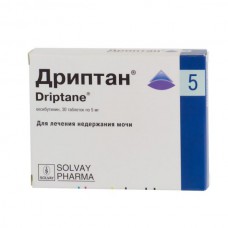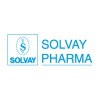Expiration date: 02/2027
The composition and form of issue:
Tablets. 1 tablet contains:
oxybutynin hydrochloride 5 mg
excipients: MCC, calcium stearate, lactose anhydrous
blistere in 30 PCs. in cardboard pack 1 blister.
Description pharmaceutical form:
Tablets white color, round, lenticular, scored on one side.
Pharmacokinetics:
Cmax after intake is reached after 45 min. the Concentration is proportional to the applied dose. T1/2 is less than 2 hours (it increases in elderly patients).
Description pharmacological action:
Relaxes the detrusor (muscle, reducing bladder). Has a direct myotropic antispasmodic m-anticholinergic action. Increases the capacity of the bladder, reduces the frequency of detruzora hinders urination.
Indications:
- urinary incontinence associated with instability of the bladder, impaired or as a result of disorders of neurogenic nature (hyperreflexia detrusor), for example in advanced multiple sclerosis or spina bifida, or idiopathic dysfunction of the detrusor (motor incontinence)
- nocturnal enuresis in children over 5 years.
Contraindications:
- hypersensitivity to the drug
- angle-closure glaucoma
- obstruction of the gastrointestinal tract, intestinal atony, the expansion of the colon, ulcerative colitis
- myasthenia gravis
- obstructive uropathy
- bleeding
- the breast-feeding period
- children up to age 5 years.
Application of pregnancy and breast-feeding:
During pregnancy Triptan is used only on strict indications. If necessary, use of the drug during lactation should decide the issue of termination of breastfeeding.
Side effects:
Nausea, constipation, diarrhea, discomfort in the abdominal area, the delay of urine, drowsiness or insomnia, weakness, headache, dizziness, arrhythmia, blurred vision (mydriasis, paralysis of accommodation), increased intraocular pressure, reduced sweating, dry mouth, impotence, allergic reactions.
Method of application and dose:
Inside. Adults — 5 mg 2-3 times a day, children and elderly patients, 5 mg 2 times a day.
Overdose:
Symptoms: initiation of CNS (anxiety, tremor, increased nervous irritability, convulsions, delirium, hallucinations), fever, nausea, vomiting, tachycardia, decreased blood pressure, respiratory failure, paralysis, coma.
Treatment: should support respiration, induce vomiting or perform gastric lavage, designate activated carbon and a saline laxative. For regression of symptoms used anticholinergic intoxication blockers cholinesterase (physostigmine). In marked anxiety or excitation — in/introduction of 10 mg of diazepam. With tachycardia — propranolol (in/in).
Special instructions:
Caution is necessary when impaired renal function and liver, hyperthyroidism, coronary artery disease, heart failure, arrhythmia, arterial hypertension, prostate adenoma, hernia hiatal.



